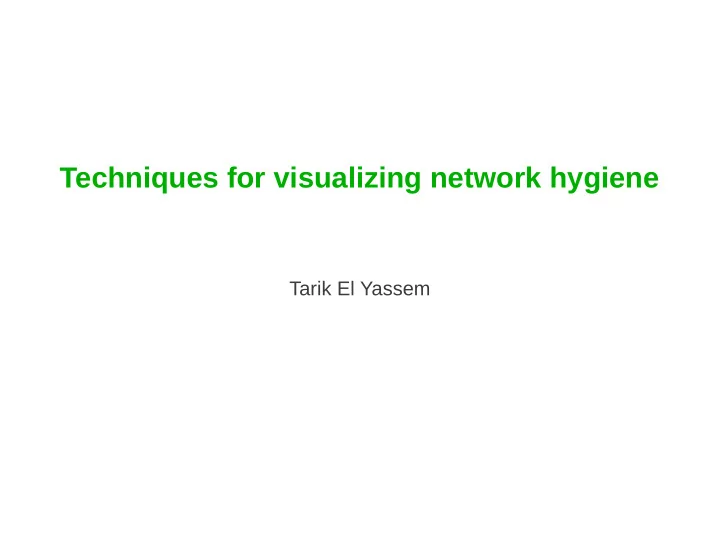

Techniques for visualizing network hygiene Tarik El Yassem
Introduction 2/19
Introduction: problem ● What's going on in that network? ● Too much to look for ● Many different information feeds ● Big data sets ● Hard to get an overview ● Incident driven ● Difficult to communicate 3/19
Theory: research question What techniques can be used to visualize network hygiene? ● That network has urgent security issues ● This threat occurs on those systems ● This customer keeps misbehaving ● Security has improved in this part of the network 4/19
Data 5/19
Data Security state Communication ● Vulnerabilities ● IDS, firewalls, honeypots... ● Abuse, NTD Networks ● AS's, netblocks, IP's 6/19
Visualization Bearing unkown rogue networks Roveta et al. (vizsec 2011 ) 7/19
Current visualisations ● VisAlert ● NICT daedalus ● Shadowserver ● Clockview 8/19
Current dashboards http://www.qualys.com/ http://www.odysseyconsultants.com 9/19
Shortcomings ● Too abstract ● Too much detail ● Too complex ● Geographical visualization not actionable ● No network overview ● Limited or no interaction 10/19
Visualizing network maps Randall Munroe (XKCD), 2006 Caida.org 11/19
Hilbert curve ● A space filling curve ● Preserves locality 12/19
Hilbert curve visualization ● Can we actually use this for something else then an Internet map of /8's? ● CIDR? ● IPv6? ● Is it feasible to use in an interactive dashboard? 13/19
Demo 14/19
Hilbert curve implementation ● Different depth for AS/Netblocks/IP's ● Not one same netblock size ● Level >7: ● Higher level = too many tiny specs ● Issue for some CIDR ranges and IPv6 – IPv4 > /18 – IPv6 ● /48 as 256 /56's ● /56 as 256 /64's ● Filter: IP's with no data, risk level 15/19
Architecture 16/19
MongoDB schema 17/19
Conclusions ● Flexible and scalable architecture ● Hilbert curve useful – Aggregation – Filtering – Browser limitations – Can work for IPv6 – Combine with statistics and traffic viz ● Poc, work in progress. Looks promising. 18/19
Questions? 19/19
Recommend
More recommend